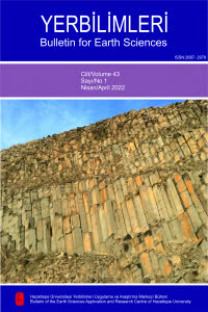Large spatial dispersion of the main shock epicenter of the 1944 Gerede earthquake (NW Anatolia, Turkey): A fault-triggering mechinsm?
1944 Gerede depreminin (KB Anadolu, Türkiye) ana sarsıntı merkezüstünün geniş mekansal dağılımı: Bir fay tetikleme mekanizması?
___
Alptekin, O., Nabelek, J.L., and Toksöz, M.N., 1986. Source mechanism of the Bartın earthquake of September 3, 1968, in northwestern Turkey: evidence for active thrust faulting at the southern Black Sea margin. Tectonophysics, 122, 73-88.Barka, A., 1992. The North Anatolian fault zone. Annales Tectonicae, VI, 164-195.
Blumenthal, M., 1948. Bolu civarı ile arasındaki Kızılırmak mecrası arasındaki Kuzey Anadolu silsilelerinin jeolojisi (Un aperçu de la geologie des chaines nordanatoliennes entre l'Ova de Bolu et le Kızılırmak inferieur). Publications d l'Institut d'Etudes et de Recherches Miniires en Turquie). Serie B, No. 13, Ankara, 265 pp.
Dercourt, J., Zonenshain, L.P., Ricou, L.E., Kazmin, V.G., LePichon, X., Knipper, A.L., Grandjacquet, C., Sbortshikov, I.M., Geyssant, J., Lepvrier, C., Pechersky, D.H., Boulin, J., Sibuet, J.C., Savostin, L.A., Sorokhtin, O., Westphal, M., Bazhenov, M.L., Lauer, J.P., and Biju-Duval, B., 1986. Geological evolution of the Tethys belt from the Atlantic to Pamir since the Lias. Tectonophysics, 123, 241-315.
Ergin, K., Güçlü, U., and Uz, Z., 1967. A catalog of earthquakes for Turkey and surrounding area (11 A.D. to 1964 A.D.). İTÜ Mining Faculty, Institute of Earth Physics, No. 24, 169 pp.
Eyidoğan, H., Utku, Z., Güçlü, U., and Değirmenci, E., 1991. The macro-seismic guide to the large earthquakes of Turkey (1900-1988). Technical University of Istanbul, Faculty of Mining, Department of Geophysical Engineering, 199 pp.
Gencoğlu, S., İnan, E., and Güler, H., 1990. The earthquake hazard in Turkey. Publication of the Chamber of Geophysical Engineers, Ankara, 701 pp (in Turkish).
Ketin, I., 1969. About the North Anatolian Fault. Bulletin of the Mineral Research and Exploration Institute Turkey, 72, 1-27 (in Turkish and German).
KOERI, 2003: http://www.koeri.boun.edu.tr (Kandilli Observatory, February 2003).
McKenzie, D.P., 1972. Active tectonics of the Mediterranean region. Geophysical Journal of Royal Astronomical Society, 30, 109-185.
MTA, 1989. Geological map of Turkey, scale 1/2.000.000. Maden Tetkik ve Arama Enstitüsü, Ankara.
Philip, H., Cisternas, A., Gvishiani, A., and Gorshkov, A., 1989. The Caucasus: an actual example of the initial stages of continental collision. Tectonophysics, 161, 1-21.
Reilinger, R. E, McClusky, S. C., Oral, M. B., King, R. W., Toksöz, M. N., Barka, A. A., Kınık, I., Lenk, O., and Sanlı, I., 1997. Global positioning system measurements of present-day crustal movements in the Arabia-Africa-Eurasia plate collision zone. Journal of Geophysical Research, 102, B5, 9983-9999.
Şaroğlu, F., 1988. Age and offset of the North Anatolian Fault. Middle East Technical University Journal of Pure and Applied Sciences, 21(1-3), 65-79.
Şengör, A.M.C., 1984. The North Anatolian transform fault: its age, offset and tectonic significance. Journal of Geological Society of London, 136,269-282.
Tüysüz, O., 1993. A geo-traverse from the Black Sea to the Central Anatolia: Tectonic evolution of the northern Neo-Tethys. Turkish Association of Petroleum Geologists Bulletin. 5/1, 1-33.
USGS-NEIC, 2003: http://neic.usgs.gov/neis/sopar (February 2003).
- ISSN: 1301-2894
- Yayın Aralığı: 3
- Başlangıç: 1976
- Yayıncı: Hacettepe Üniversitesi Yerbilimleri Uygulama ve Araştırma Merkezi
Murat UTKUCU, Ali PINAR, Ömer ALPTEKİN
Çatmakaya (Seydişehir-Konya) boksit yatağının jeolojik ve petrografik özellikleri
M. Muzaffer KARADAĞ, Sedat TEMUR, FETULLAH ARIK, Alican ÖZTÜRK
Ayşegül YILDIZ, Vedia TOKER, Huriye DEMİRCAN, Serkan SEVİM
1 Mayıs 2003 Bingöl depremi (Mw=6.4) kuvvetli hareket kayıtlarının incelenmesi
